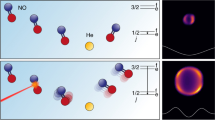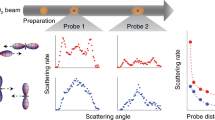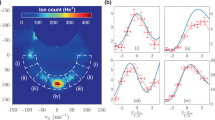Abstract
Scattering resonances play a central role in collision processes in physics and chemistry. They help build an intuitive understanding of the collision dynamics due to the spatial localization of the scattering wavefunctions. For resonances that are localized in the reaction region, located at short separation behind the centrifugal barrier, sharp peaks in the reaction rates are the characteristic signature, observed recently with state-of-the-art experiments in low-energy collisions. If, however, the localization occurs outside of the reaction region, mostly the elastic scattering is modified. This may occur due to above-barrier resonances, the quantum analogue of classical orbiting. By probing both elastic and inelastic scattering of metastable helium with deuterium molecules in merged-beam experiments, we differentiate between the nature of quantum resonances—tunnelling resonances versus above-barrier resonances—and corroborate our findings by calculating the corresponding scattering wavefunctions.

This is a preview of subscription content, access via your institution
Access options
Access Nature and 54 other Nature Portfolio journals
Get Nature+, our best-value online-access subscription
$29.99 / 30 days
cancel any time
Subscribe to this journal
Receive 12 print issues and online access
$259.00 per year
only $21.58 per issue
Buy this article
- Purchase on Springer Link
- Instant access to full article PDF
Prices may be subject to local taxes which are calculated during checkout





Similar content being viewed by others
Data availability
The data that support the findings of this study are available from the corresponding authors on reasonable request. Source Data for Fig. 3 is provided with the paper.
References
Friedrich, H. Scattering Theory 2nd edn (Springer, 2016).
Császár, A. G. et al. Rotational–vibrational resonance states. Phys. Chem. Chem. Phys. 22, 15081–15104 (2020).
Feshbach, H. Unified theory of nuclear reactions. Ann. Phys. 5, 357–390 (1958).
Fano, U. Effects of configuration interaction on intensities and phase shifts. Phys. Rev. 124, 1866–1878 (1961).
Chin, C., Grimm, R., Julienne, P. & Tiesinga, E. Feshbach resonances in ultracold gases. Rev. Mod. Phys. 82, 1225–1286 (2010).
Yang, H. et al. Observation of magnetically tunable Feshbach resonances in ultracold 23Na40K + 40K collisions. Science 363, 261–264 (2019).
Clary, D. C. & Henshaw, J. P. Chemical reactions dominated by long-range intermolecular forces. Faraday Discuss. Chem. Soc. 84, 333–349 (1987).
Quéméner, G. & Julienne, P. S. Ultracold molecules under control! Chem. Rev. 112, 4949–5011 (2012).
Schutte, A., Bassi, D., Tommasini, F. & Scoles, G. Orbiting resonances in the scattering of H atoms by mercury at thermal energies. Phys. Rev. Lett. 29, 979–982 (1972).
Toennies, J. P., Welz, W. & Wolf, G. Observation of orbiting resonances in the integral cross section of H–Xe. J. Chem. Phys. 61, 2461–2462 (1974).
Toennies, J. P., Welz, W. & Wolf, G. Observation of orbiting resonances in H2–rare gas scattering. J. Chem. Phys. 64, 5305–5307 (1976).
Grover, J. R., Toennies, J. P., Welz, W. & Wolf, G. The observation of resonance maxima in H + CF4 and H + SF6 scattering. Chem. Phys. Lett. 48, 24–28 (1977).
Toennies, J. P., Welz, W. & Wolf, G. Molecular beam scattering studies of orbiting resonances and the determination of van der Waals potentials for H–Ne, Ar, Kr, and Xe and for H2–Ar, Kr, and Xe. J. Chem. Phys. 71, 614–642 (1979).
Boesten, H. M. J. M., Tsai, C. C., Verhaar, B. J. & Heinzen, D. J. Observation of a shape resonance in cold-atom scattering by pulsed photoassociation. Phys. Rev. Lett. 77, 5194–5197 (1996).
Skodje, R. T. et al. Observation of a transition state resonance in the integral cross section of the F + HD reaction. J. Chem. Phys. 112, 4536–4552 (2000).
Qiu, M. et al. Observation of Feshbach resonances in the F + H2 → HF + H reaction. Science 311, 1440–1444 (2006).
Manolopoulos, D. E. et al. The transition state of the F + H2 reaction. Science 262, 1852–1855 (1993).
Kim, J. B. et al. Spectroscopic observation of resonances in the F + H2 reaction. Science 349, 510–513 (2015).
Henson, A. B., Gersten, S., Shagam, Y., Narevicius, J. & Narevicius, E. Observation of resonances in Penning ionization reactions at sub-kelvin temperatures in merged beams. Science 338, 234–239 (2012).
Osterwalder, A. Merged neutral beams. EPJ Tech. Instrum. 2, 10 (2015).
Chefdeville, S., Kalugina, Y., van de Meerakker, S. Y. T., Lique, F. & Costes, M. Observation of partial wave resonances in low-energy O2–H2 inelastic collisions. Science 341, 1094–1096 (2013).
Vogels, S. N. et al. Imaging resonances in low-energy NO–He inelastic collisions. Science 350, 787–790 (2015).
Vogels, S. N. et al. Scattering resonances in bimolecular collisions between NO radicals and H2 challenge the theoretical gold standard. Nat. Chem. 10, 435–440 (2018).
Bergeat, A. et al. Understanding the quantum nature of low-energy C(3Pj) + He inelastic collisions. Nat. Chem. 10, 519–522 (2018).
Beyer, M. & Merkt, F. Half-collision approach to cold chemistry: shape resonances, elastic scattering, and radiative association in the H+ + H and D+ + D collision systems. Phys. Rev. X 8, 1–15 (2018).
Ren, Z. et al. Probing the resonance potential in the F atom reaction with hydrogen deuteride with spectroscopic accuracy. Proc. Natl Acad. Sci. USA 105, 12662–12666 (2008).
Lavert-Ofir, E. et al. Observation of the isotope effect in sub-kelvin reactions. Nat. Chem. 6, 332–335 (2014).
Eppink, A. T. J. B. & Parker, D. H. Velocity map imaging of ions and electrons using electrostatic lenses: application in photoelectron and photofragment ion imaging of molecular oxygen. Rev. Sci. Instrum. 68, 3477–3484 (1997).
Ashfold, M. N. R. et al. Imaging the dynamics of gas phase reactions. Phys. Chem. Chem. Phys. 8, 26–53 (2006).
Even, U. The Even–Lavie valve as a source for high intensity supersonic beam. EPJ Tech. Instrum. 2, 17 (2015).
Klein, A. et al. Directly probing anisotropy in atom-molecule collisions through quantum scattering resonances. Nat. Phys. 13, 35–38 (2017).
Skodje, R. T. et al. Resonance-mediated chemical reaction: F + HD → HF + D. Phys. Rev. Lett. 85, 1206–1209 (2000).
Yang, T. et al. Extremely short-lived reaction resonances in Cl + HD (v = 1) → DCl + H due to chemical bond softening. Science 347, 60–63 (2015).
Wang, T. et al. Dynamical resonances in chemical reactions. Chem. Soc. Rev. 47, 6744–6763 (2018).
Moiseyev, N. Non-Hermitian Quantum Mechanics (Cambridge Univ. Press, 2011).
Yun, R., Narevicius, E. & Averbukh, V. Penning ionization widths by Fano-algebraic diagrammatic construction method. J. Chem. Phys. 148, 114101 (2018).
Zhang, D. & Willitsch, S. in Cold Chemistry: Molecular Scattering and Reactivity Near Absolute Zero (eds Dulieu, O. & Osterwalder, A.) Ch. 10 (Royal Society of Chemistry, 2018).
Luria, K., Lavie, N. & Even, U. Dielectric barrier discharge source for supersonic beams. Rev. Sci. Instrum. 80, 104102–104104 (2009).
Blech, A. et al. Phase protection of Fano-Feshbach resonances. Nat. Commun. 11, 999 (2020).
Margulis, B., Narevicius, J. & Narevicius, E. Direct observation of a Feshbach resonance by coincidence detection of ions and electrons. Nat. Commun. 11, 1–6 (2020).
Wiley, W. C. & McLaren, I. H. Time-of-flight mass spectrometer with improved resolution. Rev. Sci. Instrum. 26, 1150–1157 (1955).
Janssen, L. M. C., van der Avoird, A. & Groenenboom, G. C. Quantum reactive scattering of ultracold NH(X3Σ–) radicals in a magnetic trap. Phys. Rev. Lett. 110, 1–5 (2013).
Manolopoulos, D. E. Derivation and reflection properties of a transmission-free absorbing potential. J. Chem. Phys. 117, 9552–9559 (2002).
Londoño, B. E., Mahecha, J. E., Luc-Koenig, E. & Crubellier, A. Shape resonances in ground-state diatomic molecules: general trends and the example of RbCs. Phys. Rev. A 82, 012510 (2010).
Acknowledgements
We acknowledge financial support from the European Research Council and the Israel Science Foundation. Additional financial support from the German–Israeli Foundation (grant no. 1254) is gratefully acknowledged. C.P.K. is grateful for a Rosi and Max Varon Visiting Professorship. Correspondence and requests for materials should be addressed to E.N. and C.P.K.
Author information
Authors and Affiliations
Contributions
P.P. and N.D. carried out the experiments. D.M.R. performed the calculations with help from A.v.d.A. C.P.K. and E.N. conceived and supervised the work. All authors discussed the results and wrote the manuscript.
Corresponding authors
Ethics declarations
Competing interests
The authors declare no competing interests.
Additional information
Publisher’s note Springer Nature remains neutral with regard to jurisdictional claims in published maps and institutional affiliations.
Extended data
Extended Data Fig. 1 Partial and total rate coefficients for elastic scattering of He* with normal D2.
The black curve denotes the partial elastic scattering rate coefficient integrated only over the backward hemisphere. The red curve denotes the total elastic scattering rate coefficient (integrated over all scattering angles). Note the different y-scales for the partial and total rate coefficients.
Source data
Source Data Fig. 3
Rate coefficients as a function of collision energy for elastic collisions and Penning ionization of He* + D2.
Rights and permissions
About this article
Cite this article
Paliwal, P., Deb, N., Reich, D.M. et al. Determining the nature of quantum resonances by probing elastic and reactive scattering in cold collisions. Nat. Chem. 13, 94–98 (2021). https://doi.org/10.1038/s41557-020-00578-x
Received:
Accepted:
Published:
Issue Date:
DOI: https://doi.org/10.1038/s41557-020-00578-x
This article is cited by
-
The topology of the reaction stereo-dynamics in chemi-ionizations
Communications Chemistry (2023)
-
Associative detachment in anion-atom reactions involving a dipole-bound electron
Nature Communications (2022)
-
Anisotropic dynamics of resonant scattering between a pair of cold aligned diatoms
Nature Chemistry (2022)
-
Quantum logic detection of collisions between single atom–ion pairs
Nature Physics (2022)
-
Selectivity of weak intermolecular forces and precursor state of elementary oxidation reactions, a new insight on Ne* + N2 chemiionization
Scientific Reports (2021)



